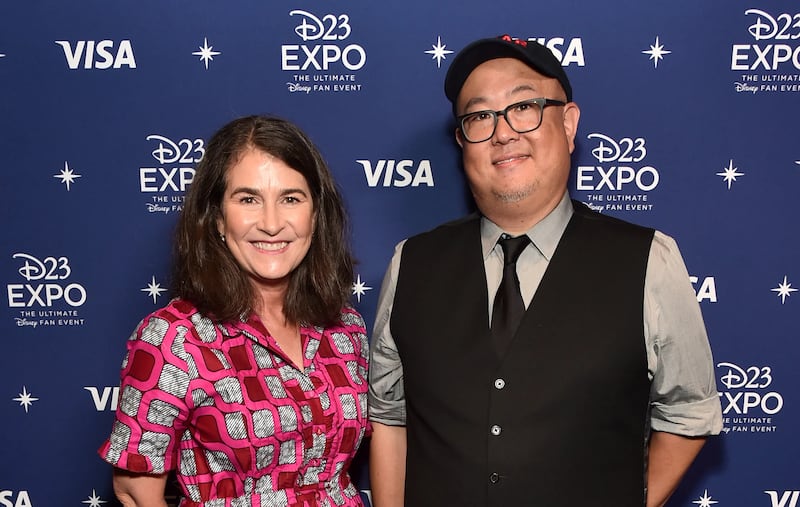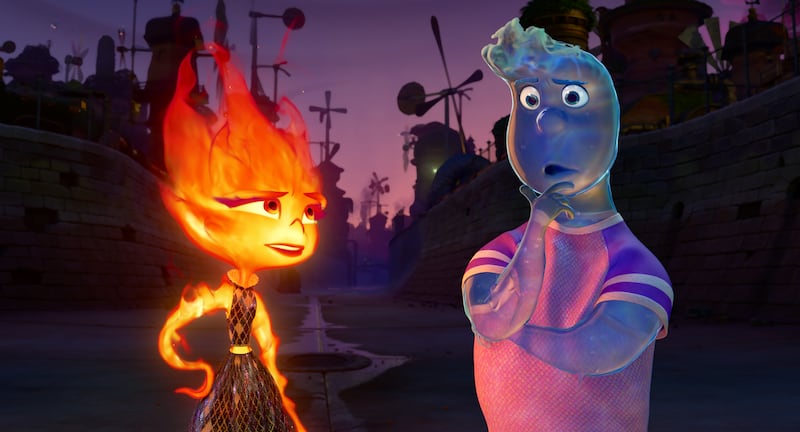Let us get one biographical detail out of the way first. Before meeting Peter Sohn, director of Pixar’s latest animated feature, I read he was the visual inspiration for Russell in the studio’s immortal Up. You remember. The bumbling Asian-American kid who disrupts Carl Fredricksen’s grumpy isolation. Sohn, whose Elemental just closed the Cannes film festival, is now in his mid-40s, but… How can I put this? It’s him. It’s definitely Russell. All grown-up.
At least until he speaks.
“Yes!” he says, laughing heartily. “That came from caricatures drawn in the story room. You’re always drawing each other. So one of the artists drew me as a giant thumb with a hat. And that became this ongoing joke. They started picking pieces of my childhood. I was a cub scout in the city and they were like: ‘What wilderness training could you possibly do in a city?’ And that became the seeds of the character.”
[ DeSantis rejects Disney lawsuit against him as politicalOpens in new window ]
It hardly needs to be clarified that Sohn, a Korean-American who has worked at Pixar for 20 years, makes a lot more sense than poor old Russell. He is bearing a great deal of responsibility. Since 1995, when Toy Story emerged to a sensational response, the studio has been a prime force in family entertainment. The digital animation was ground-breaking, but, as no review failed to mention, the studio also deserved praise for the brilliance of its scripts. Movies such as Finding Nemo,WALL-E and Up required no Shreky snark to connect equally with adults and children. The occasional hiccup such as Cars noted, the golden age looks to have lasted up to Inside Out in 2015.
READ MORE

Elemental, an allegorical tale of romance between a water sprite and a fiery being, arrives at an awkward time for the industry. Top Gun: Maverick was supposed to have saved the theatrical business last year, but, in truth, only a handful of movies are making serious coin. True, global box office grew 27 per cent in the first quarter of 2023. But the highest grosser this year is – by a depressing mile – The Super Mario Bros Movie with $1.3 billion. Fast X and Guardians of the Galaxy have yet to get within spitting distance of that total.
Meanwhile, Pixar, owned by Disney, has yet to fully recover from a pandemic slump. Industry-watchers wonder at the wisdom of the studio sending such titles as Soul, Luca and Turning Red straight to the Disney+ streaming service during lockdown and in the early days of normal service. Last year, the ho-hum Lightyear, a spin-off from Toy Story, disappointed with just $227 million (more than a billion less than the Super Mario flick). Following our conversation, Elemental endures one of Pixar’s worst-ever opening weekends.
“Disney’s pandemic strategy of streaming-only distribution, among other creative disruptions, for several of their well-reviewed films did a disservice to the brand,” Shawn Robbins, chief analyst at BoxOffice.com, recently told CNBC. “One which new leadership is trying to mend now.”
Denise Ream, the experienced producer of Elemental, is aware of her responsibility to the Pixar empire.
“It’s exhilarating and terrifying all at the same time,” she says. “We’ve made it for the big screen, you know. It’s intended to be seen at the movies. I’m encouraged that people are going back to the movies and going to see animated films. Fingers crossed people connect with it. We are all just trying to do the best we can to create something that’s entertaining, something that’s heartfelt.”
Pixar has produced some excellent films over the past decade. Inside Out won the animated feature Oscar in 2016. Coco from 2017 also has its fans. But the unstoppable – again, useless Cars noted – hit rate of the early years is no longer in place. The company also lost some brand identity. In 1995, they were literally the only people producing computer-animated features (just as, over 50 years ago, Walt Disney was the only company producing any sort of animated feature). Now every major studio is in the same business. Pixar and their stablemates at Walt Disney Animation are no longer so easy to distinguish. Could you tell without any clues which produced Encanto (it was Disney) and which produced The Good Dinosaur (Pixar)? What is now the distinction between what they do?
“Gosh, that’s a good question,” Ream says. “We don’t interact that much as two companies. They do more musicals. I’d say there is a subtle aesthetic difference as well. I think being up in the Bay Area kind of separates us from Hollywood. We are more aligned with the tech companies in many respects – in terms of how we operate.”
That is an interesting point. Walt Disney has been physically in or around Hollywood for almost exactly a century. Though Pixar, largely the brain child of John Lasseter, director of Toy Story, did start as part of George Lucas’s company, it was Steve Jobs, sultan of Apple, who – with a few bumps along the way – shepherded them through their great successes of the pre-millennial years. Pixar has long been based in the San Francisco Bay Area, close to 400 miles north of Hollywood. As I understand it, the ethos is all beanbags on the floor, Dave Matthews on the speakers and pinball machines in the board room.
“I always believed Pixar had an independent spirit to it,” Sohn says. “It was a little bit more rebellious when they first started it with Toy Story. We don’t have a villain. There are no musical numbers. We find something more authentic in terms of a character’s journey. That spirit continues to live at Pixar. Something that defines us is there’s always this independent-film spirit to the beginning of these projects. They have personal seeds to them that you rarely see in the big Disney features.”
[ Walt Disney Co begins 7,000 layoffs as it seeks to cut costsOpens in new window ]
Lasseter left the company in 2018, but some of the old guard are still around. The famously agreeable Pete Docter, director of Up and Inside Out, executive-produced Elemental and he was there in Cannes to put the film before the world. Do they still feel his hand on the tiller?
“He’s also a film-maker and there is a common language,” Sohn explains. “That helps us understand why a certain decision would make something better. And his gut was right most of the time on this. We couldn’t have looked for a better executive producer.”
Elemental essentially works as an analogy for the great American melting pot. Pay attention, because this could be confusing. We are in a city inhabited by anthropomorphic manifestations of the natural elements: earth, water, fire, maybe others. Water seems stand in for the Wasp establishment. The Fire things look to be modelled on east Asian communities. When a fire element falls for a water element their families are divided, but, all going well, love will find a way. There is a little bit of Ernst Lubitsch’s The Shop Around the Corner there. There is a little more of Guess Who’s Coming to Dinner in adjacent wings. I wonder how much of the texture comes from Sohn’s experiencers as a Korean-American.

“I never wanted the communities of elements to appropriate any one culture or to represent one singular culture,” he says. “But you have to find specificity within those cultures to make them feel authentic. We would take a gesture – a bow, for example – do the research behind that, and then find a way to make it connect to the fire element. The game was trying to make fire itself a unique property. When devising the language, the idea was: could we make it sound like a fireplace? Ha, ha!”
The film echoes one aspect common to so many films on the immigrant experience. The younger generation’s greater level of assimilation plants barriers between themselves and their parents. The first generation want their kids to get on, but they don’t want them to lose all connection with the old country.
“My parents had a line,” Sohn continues. “What I mean by that is there was only so far that they would assimilate. My mother did not want to learn the language as well as my father did. She was definitely keeper of the torch of Korean culture in the house. She only spoke Korean to us. A lot of those ingredients came into the film. But the idea of acculturation and the idea of a melting pot is a more modern idea. That was different to my upbringing, That is something that I love for my own children.”
He has not only helped mould one of the nation’s great cultural institutions, he has also lent his image to one of that institution’s more adorable creations. Being the face of Russell in Up is a little like being the face of the Road Runner or of Charlie Brown. Can he disassociate himself from the fictional creation?
“All these characters have seeds of personal stuff,” he says patiently. “Everything has to be created. The fabric. The hair. The voice acting of Jordan Nagai. It is easy to connect because there are so many artists.”
Yeah, but still. He’s a good bit of Russell. How cool is that?
Elemental is in cinemas from July 7th












